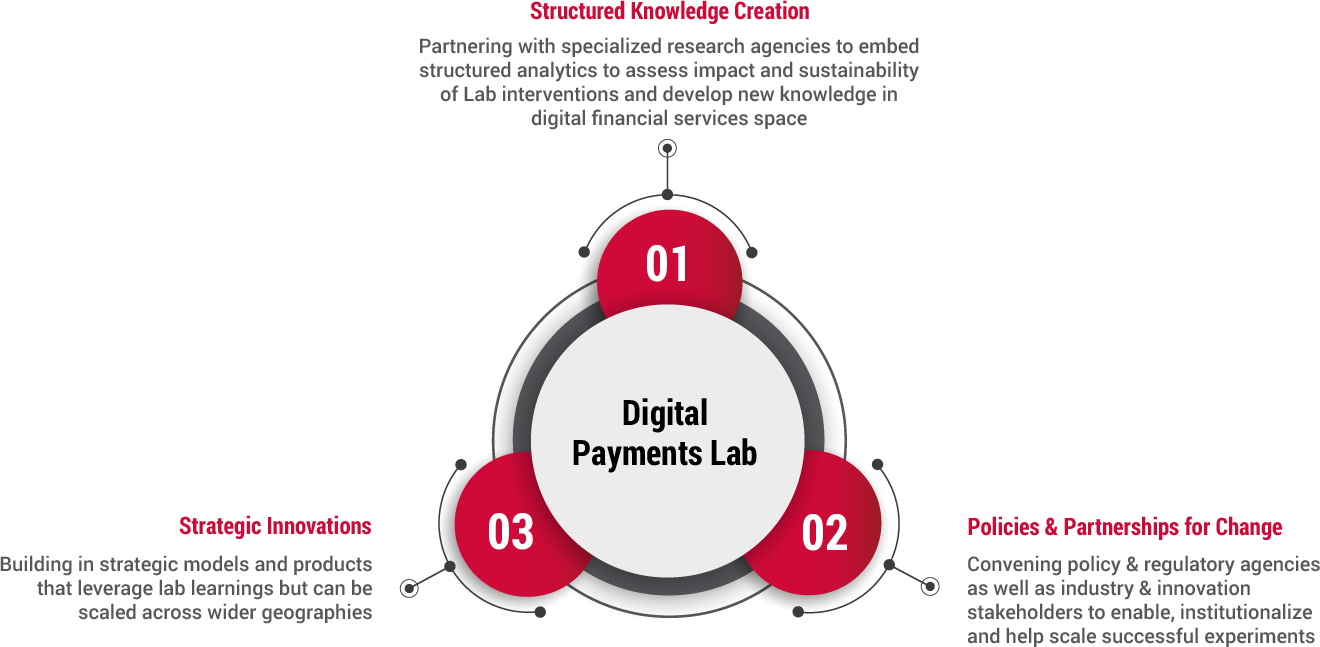PILOT PROJECT
ALTERNATIVE LENDING PROJECT
Using transaction data trails from digital payments, the project tested if digital remittance data can be used to appraise credit-worthiness of financially excluded small business owners and provide them loans of small ticket size over shorter durations
ABOUT THE PROJECT
Period: September 2015 - March 2016
Partners: YES BANK (data provider) and Lendingkart (lender)
Objective: To test if digital remittance data are a viable source for credit appraisal and loan provision to financially underserved small businesses and entrepreneurs
Project overview: Yes Bank runs a remittance service business called Yes Money, which commissions a network of agents called Yes Money Agents. These agents require working capital to maintain sufficient balance in their Yes Bank wallets, which are used to complete remittance transactions for their customers. As part of this project, Yes Bank shared its agents’ remittance data with Lendingkart, who, in turn, analyzed these data to assess agents’ credit worthiness, and offered them working capital loans.
In this pilot, Yes Bank shared a six-month remittance data history for 639 of its remittance agents (carrying out remittance transactions of a minimum total value of INR 5 lakh per month) with Lendingkart. Specific data points included frequency of deposits made, amount transferred and number of transactions completed.
Lendingkart used the remittance data to assess the credit worthiness of the agents, and reached out to the identified agents to enquire about their credit need. Agents who expressed interest, and met the predefined criteria, were offered working capital loans (of tenure as short as three months) and of ticket sizes as low as INR 25,000, based on their business turnover and financial discipline. Lendingkart disbursed a total of seven loans over the course of this project.
PROBLEM STATEMENT
Vijay, a Mumbai-based small business owner, operates a remittance business as a Yes Money agent, and carries out remittance transactions of ~INR 1.5 lakh (US$2,000) on average per week. This accounts for nearly 10 percent of his total income. With the trust he enjoys from his community, Vijay believes he can transact about double of his current volumes. However, at the end of every month, he finds himself strapped — with a low balance on his Yes Money wallet and limited means to access working capital from external sources.
Vijay seeks a small business loan of INR 25,000 (~ US$375) to maintain a higher wallet balance so that he can increase the number of remittance-based transactions that he currently carries out. He expects to pay this back in three or four months, but he faces two key challenges in accessing formal credit -
- His inability to meet banks’ standardized lending criteria (e.g., robust credit history, collateral, etc.); and
- A mismatch between his credit need, and terms offered by traditional financial institutions (e.g., small amounts of credit over varying durations of time that he needs, as opposed to bigger ticket sized loans with a long repayment period that banks typically offer).
ROLE OF STAKEHOLDERS IN THE ALTERNATIVE LENDING PILOT
DETAILS OF LOANS DISBURSED
KEY LEARNINGS
User Experience
The remittance data-based lending model helped meet a significant unmet need for credit. Traditional lenders usually do not cater to small ticket, short tenure loans. With its specialized working capital offering (low ticket size loans for three to nine months), Lendingkart was able to meet this need. For example, six out of seven merchants took loans in the range of INR 25,000 to INR 60,000 (while one agent received INR 700,000).
Remittance data helped Lendingkart reach out to a different segment of merchants such as small and medium offline merchants with lower annual revenues (INR 1,000,000 to 1,200,000 per annum). Lendingkart traditionally provides working capital and short-term business loans in the range of INR 50,000 to INR 10 million to online and large offline merchants with annual turnovers of INR 1,800,000 to 2,400,000. It significantly altered its product to suit the needs of this new customer segment and provided loans of much smaller ticket sizes.
Remittance data were helpful in identifying a new potential set of borrowers. However, these data alone were not sufficient to make a lending decision. This is because income from remittance-based transactions is not an accurate indicator of the agents’ total income. Supplemental data – such as bank statements – facilitated the loan underwriting process, enabling the actual lending decision as they more accurately reflect borrowers’ financial discipline and capability to pay back the loan.
The Lendingkart loan took a fraction of the time for processing and required far less documentation than loans from traditional lenders. Loans offered by Lendingkart took under seven days to process. No collaterals or other paperwork in the form of house ownership documents, business ownership documents, insurance policies, etc., were needed to approve the loan. On the net promoter score scale of 0 to 10, the agents gave Lendingkart an average of about 8.56.
Agents recognized that they were getting the loan based on their transaction data, but they were not able to establish a relationship between digital payments and their ability to access the loan. Agents were unable to recognize the role played by digital payments in creating their transaction data trails, which formed the basis for the loans from Lendingkart. Proactive communication will be required to emphasize this link to drive greater adoption of digital payments by these agents (including accepting digital payments for C2B transactions).
Interesting reads
- Best Casino Not On Gamstop
- Best Casino Not On Gamstop
- Top Casino Online 2025
- Casinos Not On Gamstop
- Non Gamstop Casinos
- Casino Not On Gamstop
- Sites Not On Gamstop
- Slots Not On Gamstop
- Slots Not On Gamstop
- Meilleur Casino En Ligne
- Casino Not On Gamstop
- Online Casinos Canada
- Casino En Ligne France
- Non Gamstop Casino Sites UK
- Non Gamstop Casino UK
- Gambling Sites Not On Gamstop
- Best Casino Sites In UK
- Casinos Not On Gamstop
- Meilleur Casino En Ligne Fiable
- Non Gamstop Casino
- Online Casinos Nederland
- Casino Non Aams Sicuri
- Best Non Gamstop Casino
- Non Aams Casino
- Casino Italiani Non Aams
- Casino En Ligne Bitcoin
- Casino En Ligne Belgique Liste
- Meilleur Casino En Ligne


